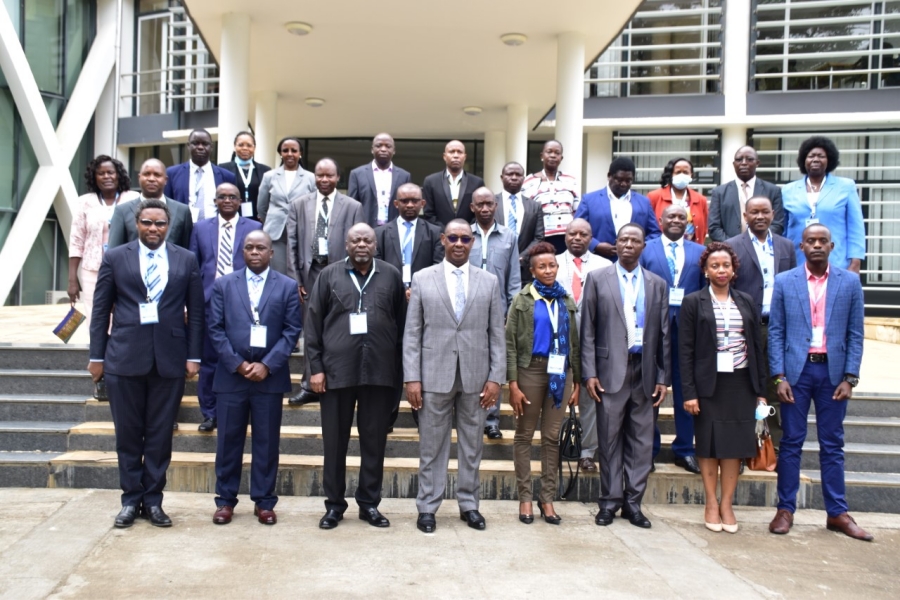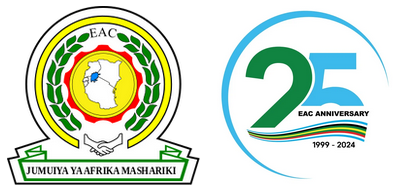
Lake Victoria Fisheries Organization project aimed at promoting Fish Farming launched
East African Community Headquarters, Arusha, Tanzania, 1st June, 2021: The Lake Victoria Fisheries Organization (LVFO), a specialized institution of the EAC based in Jinja, Uganda, has unveiled a 10 million euros project that seeks to promote aquaculture (fish farming) in East Africa.
In a speech read on his behalf by the EAC Director General Customs and Trade, Mr. Kenneth Bagamuhunda at the launch of the project in Arusha, EAC Secretary General Hon. Dr. Peter Mathuki, said that the True Fish project was designed to address or remove impediments to growth in aquaculture faced by investors, for instance, lack of technical skilled operators, lack of investment finance and business planning and incomplete networks.
“The second objective of the TrueFish project is to address identified threats which could undermine the sustainability of aquaculture development, or could impact negatively on the environment, food security or livelihoods especially biosecurity risks such as fish diseases and introduction of non-native species that has led to the loss of biodiversity,” said Dr. Mathuki.
The Secretary General singled out some of the challenges facing the fishing industry on Lake Victoria as steadily declining stocks of Nile perch and tilapia, fish diseases, uncontrolled proliferation of fish farms and rising water levels.
On his part, LVFO Executive Secretary Prof. Shigalla Mahongo, disclosed that the European Union Commission was financing the project under the 11th European Development Fund (EDF) Regional Indicative Programme to the tune of 10,150,000 Euros.
“The EDF contribution is 10 million Euros, while 150,000 Euros is co-financed by potential grant beneficiaries,” said Prof. Mahongo.
Prof. Mahongo said that despite various efforts of the countries around Lake Victoria to ensure sustainability of the traditional fishing methods, demand for fish had increased considerably due to increased population, increased incomes and urbanization.
“Whilst human population in the LVFO Partner States was only 23.5 million in 1954, a reference period when Nile perch was introduced in Lake Victoria, the human population grew seven times by 2018 to 165.5 million. Therefore, the capture fisheries of Nile perch and tilapia are no longer able to satisfy the ever-increasing demand for fish in the region,” said Prof. Mahongo.
The Executive Secretary said that despite global aquaculture production surpassing harvests from capture fisheries for the first time in 2014, fish farming in the EAC region was still at its infant stage, accounting for approximately only 7-8% of fish consumption.
“The overall demand for fish in the region will continue increasing thus developing aquaculture to meet the ever-increasing demand for fish is inevitable,” said the Executive Secretary.
Speaking at the event, Mr. Jose Parajua, a Fisheries Technical Adviser at the Food and Agriculture Organization (FAO) described the negative impact of the introduction of the Nile perch species on Lake Victoria almost six decades ago.
“Obviously, the entire food web in the lake underwent all kinds of changes due to the voracious Nile perch. Many small and colourful fish species disappeared from the lake forever. The Nile tilapia that was also introduced a few decades earlier wiped out some original other tilapia species,” said Mr. Parajua.
“In that dynamic interaction between nature and fisheries LVFO had to make decisions how to assure food security for the riparian populations while at the same time looking after the economic interests of the neighbouring countries through the continuous export of the largest money-maker, the earlier-mentioned Nile perch,” said the FAO expert, adding that the LVFO had done much to address the challenges.
“The LVFO could not stop the influx of numerous additional fishers, fishmongers, fish traders and other fisheries professionals and the overexploitation of the perch became a fact. Also, the Nile tilapia was hit hard by the fishing intensity, but nature came up with a solution as there was suddenly much space for a small fish species, also known as dagaa in Tanzania, mukène in Uganda and omèna in Kenya,” he said.
Mr. Parajua said that Nile perch was very important for the food and nutrition security of the people residing around and far from the lake.
“The dried form of this fish found its way to Burundi, DR Congo, South Sudan and beyond. As the quantities fished were enormous, this species found its way into poultry feed producers and eventually also into fish feed,” he said.
“There was the continuous demand for fish from the lake. If the fisheries could not supply the fish then fish had to be reared outside the lake. Many entrepreneurs started fish farms for Nile tilapia and the African catfish. The climatic conditions in the region are very conducive for fish culture in fishponds, but the region needed more fish,” said Mr. Parajua, adding that this was the genesis of cage farming on the lake.
“Why not grow the fish inside the lake, in floating cages? Once this idea was born and the results appeared encouraging, the numbers of cages started mushrooming. Small square cages initially with volumes of a few cubic metres, followed by larger circular ones, which could contain tens of thousands of fish each,” added the FAO expert.
Mr. Parajua said that the development of cage farming could easily have gone out of hand and that is why it became imperative for LVFO to prepare guidelines for cage culture development and management.
“However, the concerns were too many. Questions were raised about the possible pollution of the lake if leftover fish feed entered the lake. What about fish excrements? Where should the farms be located so that conflicts with capture fisheries could be avoided, particularly in the light of spawning and nursery grounds of other fish species?” he said.
Notes for Editors:
The TRUEFISH project has three major components whose implementation is rather complex as it involves several partners:
Component 1 is on BUSINESS (i.e. improved access to commercial networks). The contracting authority for Component 1 is the EAC but working closely with LVFO.
Component 2 is on SKILLS i.e. availability and quality of local skilled workers in aquaculture-related businesses:
Expected Result: Strengthened commercial networks for competitive aquaculture- related businesses. This component will be implemented by Landell Mills International, which is a Consultancy Firm.
First Expected Result: Upgraded practical training delivery by formal training institutions
Second Expected Result: Strengthened linkages between training institutions, and with aquaculture business operators.
Component 2 will be implemented by the FAO.
Component 3 is on SUSTAINABILITY (i.e. sustainable and bio-secure regional aquaculture production systems):
First Expected Result: Strengthened aquatic animal health conditions
Second Expected Result: Lake Victoria zoning, to support an orderly and sustainable cage culture development. For these two expected results under Component 3, the implementer is also FAO
Third Expected Result: Improved protection of biodiversity. This will be implemented by WorldFish Centre (Formerly ICLARM).
For more information, please contact:
Simon Peter Owaka
Senior Public Relations Officer
Corporate Communications and Public Affairs Department
EAC Secretariat
Arusha, Tanzania
Tel: +255 768 552087
Email: sowaka [at] eachq.org
About the East African Community Secretariat:
The East African Community (EAC) is a regional intergovernmental organisation of six Partner States, comprising Burundi, Kenya, Rwanda, South Sudan, Tanzania and Uganda, with its headquarters in Arusha, Tanzania.
The EAC Secretariat is ISO 9001: 2015 Certified
The EACREW will also include school competitions, sports and traditional events organised by the local communities.
The EACREW will be facilitated by the support from USAID/KEA Office through Collaborative Conservation and Management of Natural Capital Programme in the EAC.
